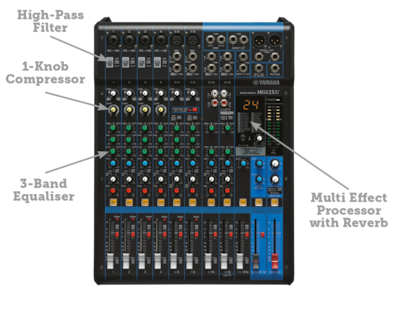Sound Systems 101
Sound Systems 101

A beginner’s guide to mixing and sound production
What is a PA System?
A PA system (Public Address system, also commonly known as a Sound Reinforcement system) is used to make a sound source louder and distribute it to a wider audience. Whether as simple as a single microphone plugged into a powered speaker, or as complex as a stadium rig with hundreds of microphones and multiple loudspeaker arrays, the key principles required to achieve professional results remain the same.
In any typical sound reinforcement system, the sound of instruments and voices are picked up by microphones and converted from acoustic sound into electrical signals. The signals are then sent through cables to the mixer, which plays an important role in balancing the volume between multiple microphones. The next stage in the journey is the power amplifier, which is used to increase the amplitude of the electrical signals received from the mixer’s outputs so the speakers can reproduce the sound. Finally, the speakers convert the electrical signals back into acoustic sound.
What is an equaliser?

What is an equaliser?
Rarely are the sounds of microphones and instruments perfect for delivery when input to the mixer. Some parts may be difficult to pick out when mixing music that features multiple instruments. In this situation adjusting only volume and panning is not sufficient, and equalisers can be used to make the best characteristics of each instrument stand out.
An equaliser allows the sound in specified frequency bands to be amplified or reduced in order to adjust the quality and character of the sound. Mixers areequipped with equalisers that adjust the tone of each channel. Some equalisers have just 2-bands, which can adjust lows and highs. Others have 3-bands, which modify the sound by boosting and cutting lows, mids and highs. Some 3-band equalisers include a MID sweep, which can modify the mid-frequencies that characterise most musical instruments and voices. The more frequency bands there are the more detailed the sound production can be.
Why use a compressor?
Vocal and instrumental performances do not always maintain the same volume. Adjusting the volume so that the audience can comfortably listen is an important element in mixing. By using a compressor on vocals - which have a wide dynamic range - the sound will not overload even if the vocalist belts out a note, making it possible to combine the vocals at an appropriate volume. When a compressor is applied to a bass guitar its sound becomes clean and smooth, making it easier to put the entire mix together. And a compressor can bring greater impact to the sounds of a snare drum or other instruments with a sharp attack.
How to make your sound more professional with a single-knob compressor
Yamaha’s 1-knob compressor features just one knob to express the kind of control used by seasoned engineers. This single-knob compressor allows you to achieve the optimal compression effect on a wide range of inputs, without the assistance of an external compression device. When using a Yamaha MG20XU mixing console - which has several built-in 1-knob compressors - it’s a good idea to use the single-knob compression function on dynamic sound sources when mixing live music.
What is reverb?
Reverb is an effect that brings a sense of spatial depth and width to sound by adding reverberation or reflections to the sound signal. For instance, using reverb makes it possible to mimic the sound of a large performance hall even if the sound is being captured in a smaller space. Reverb exists when sound reflects and echoes against the walls, floor, ceiling, or other parts of a building. When you sing inside a room the first thing you hear is the direct sound itself, after which you hear the sound reflecting off nearby walls and then echoing from all over the place. The initial reflection you hear from the walls and the echoes thereafter are collectively called “reverb”. Although reverb can add to the presence of sound, if over-used it can muddy the mix. Try adding reverb just a little bit at a time, making sure that you can hear the original sound clearly.
WORDS BY: Matt Livingstone

WORDS BY: Matt Livingstone
Matt Livingstone is the Product Manager for Professional Audio and Music Production at Yamaha Music Australia. With a strong passion for quality sound, he gained valuable experience as a freelance audio engineer across the ditch in his homeland of New Zealand. Matt also owned and operated a live sound production company, where he learned how to avoid feedback and the value of a good roll of gaffer
